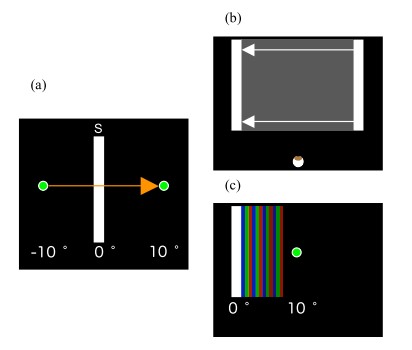人如何发生色彩分离现象
Paper代写范文:“人如何发生色彩分离现象”,这篇论文主要描述的是人的眼球在什么情况下会出现色彩分离的现象?本文通过一系列的试验对这种现象进行了研究,发现色彩分析CBU的宽度是略窄于人体眼球的运动,因此色彩分离可能以压缩图像的形式在眼睛扫视时出现。

The mechanism, how color break-up (CBU) is perceived by viewers in images produced with a field -sequential projector/ display, was considered. We measured the perceived position of the CBU during saccadic eye movements with a static stimulus and flash stimuli. Results showed that CBU was not a merely locus of the stimulus on retina during fast eye movement because width of CBU was narrower than eye movements, and that CBU is perceived similar to the compressed images which appear during saccades. Large inter - individual differences in perception of CBU were also found.
1. Introduction
When we view an image using a field- sequential projector/display such as the 1 -chip digital light projection system and when we move our eyes rapidly, such as during a saccadic eye movement, sometimes we perceive a vivid colored blur, known as color break-up (CBU). CBU is easily perceived when we view a bright pattern surrounded by a dark background.
Figure 1. (a) Bright stimulus S is projected in the dark. Circles are target of a 20 -degree saccade. The arrow indicates the direction of the eye movement. (b) The movement of the stimulus S with reference to visual axis when subject ’s saccade is similar to (a). (c) The CBU image perceived when subject’s saccade is similar to (a) .
Assume that a saccade occurred across stimulus S, which is a sequentially illuminated pattern with red=>green=>blue light, as shown in Figure 1(a). During the saccade, the corresponding image of the stimulus S moves from +10 degree to – 10 degree with reference to the visual axis, assuming that the right oriented direction is positive (see Figure 1(b)). It is known that at this moment, subjects perceive CBU as shown in Figure 1(c). In this case, S made locus from right to left, so color was perceived red=>green=>blue from right. Note that the origin of the horizontal position in Figure 1(c) is the position of the stimulus image.
The width of CBU varies depending on the stimulus luminance, contrast and other factors [1 -2]. The question arises as to whether the CBU pattern is an afterimage of the stimulus slipping on the retina during a saccade. Before answering this question, it is important to note that we never perceive the movement of the stimulus during a saccade as shown in Figure 1(b). During eye movements, the visually observed outer world is stationary: a phenomenon known as “visual stability”. A number of theories have been proposed to explain visual stability [3] , e.g., perceived position (PP) is the result of correcting the retinal image (RI) position by the eye position signal (EPS) as expressed by the formula: PP ?RI + EPS. During a saccade, if this correction were perfect, color broken retinal loci would never be perceived.
During a saccade, visual stability is not perfect and mislocalizations do happen. This phenomenon can be demonstrated using a small light flashing in the dark for a short duration. The light is perceived in the wrong position (mislocalization), and the perceived direction varies as a function of the onset time of saccadic eye movement [4], observed a relationship between localization error of the flash stimulus (2 ms) and the timing of the saccade. In this condition, mislocalization occurred from 200 ms before to 200 ms after the saccade. The error amplitude perceived was comparable to the saccadic amplitude. At this time, EPS was assumed to change slowly.
51due留学教育原创版权郑重声明:原创留学生作业代写范文源自编辑创作,未经官方许可,网站谢绝转载。对于侵权行为,未经同意的情况下,51Due有权追究法律责任。
51due为留学生提供最好的加拿大math辅导服务,亲们可以进入主页了解和获取更多paper代写范文以及留学生在线TA服务,详情可以咨询我们的客服QQ:800020041哟。-xz